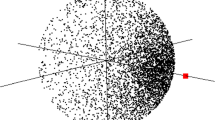Summary
The Chambers, Mallows and Stuck algorithm for stable pseudo random numbers is applied to the generation of Landau variates. The infinitely divisibility property of the Vavilov density is used to generate the variates. Use is made of the convolution between a Vavilov density with velocity β and the density of the sum of an increasing number of products of powers of independent uniform variables to generate Vavilov variates with velocity β′2 < β2 in vjew to achieve a quicker generation with the Rotondi-Montagna and Kölbig-Schorr algorithms.
Similar content being viewed by others
Bibliography
ABRAMOVITZ, I. STEGUN, “Handbook of Mathematical functions”, Dover, (1970), New York.
F.L. BAUER, “Eine Bemerkung zu Koechers Reihen für die Eulersche Konstante”, Bayer Akad. Wissen. Math (1989).
C. BERG, J.P.R. CHRISTENSEN, P. RESSEL, “Harmonie Analysis on Semigroups”, Springer Verlag, (1984), New York.
L. BONDESSON, “On Simulation from Infinitely Divisible Distributions”, Adv. Appl. Prob. 14 (1982) 855–869.
W. BORSCH-SUPAN, “On the Evaluation of the Function for Real Values of A”, J. Res. Nat.Bur. Standards 65B (1961) 245–250.
D. J. BUCKLE, “The Study of a Function Relating to Stable Distributions”, Statist. Probab. Letters 20 (1994) 85–90.
J.F. CHAMAYOU, “A Probabilistic Approach to a Differential Difference Equation arising in Analytic Number Theory”, Math. Comput, 27 (1973) 197–203.
J.M. CHAMBERS, C.L. MALLOWS, B.W. STUCK, “A Method for simulating Stable Random Variables”, J.A.S.A. 71 (1976) 354, 340–344.
P. DAMIEN, P.W. LAUD, A.F.M. SMITH, “Approximate Random Variate Generation from Infinitely Divisible Distributions with Applications to Bayesian Inference”, J.R. Statist. Soc. B57 (1995) 3, 547–563.
L. DEVROYE, “An Automatic Method for Generating Random Variates with a Given Characteristic Function”, S.I.A.M. J. Appl. Math. 46 (1986) 4, 698–719.
L. DEVROYE, “Non Uniform Random Variate Generation”, Springer (1986) New York.
D.J.S. FINDLAY, A.R. DU SAUTOY “Improvements to the Blunck-Leisegang Energy Loss Straggling Distribution”, Nuclear Inst. Meth. 174 (1980), 531–533.
D.R. HOLT, E.L. CROW “Tables and Graphs of the Stable Probability Density Functions”, J. Res. Nat. Bur. Stand. 77B (1973), 143–198.
C.D. KEMP, A.W. KEMP “Poisson Random Variate Generation”, Appl. Statist., 40 (1991), 1, 143–158.
K.S. KOLBIG, B. SCHORR, “A Program Package for the Landau Distribution”, Comput. Phys. Comm. 31 (1984) 97–111.
K.S. KOLBIG, B. SCHORR, “Asymptotic Expansions for Landau Density and Distribution Functions”, Comput. Phys. Comm. 32 (1984) 121–131.
L.D. LANDAU, “On the Energy Loss of Fast Particles by Ionization”, J. Phys (USSR) 8, (1944), 201–205.
G. LETAC, “A Characterization of the Gamma Distribution”, Adv. Appl. Prob. 17 (1985) 911–912.
E. LUKACS “Characteristic Functions”, (1970), Griffin, New-York.
R. MODARES, J.P. NOLAN, “A Method for Simulating Stable Random Vectors”, Computational Statistics 9 (1994) 11–19.
A. ROTONDI, P. MONTAGNA, “Fast Calculation of Vavilov Distribution”, Nuclear Inst. Methods. Phys. Res., B47 (1990) 215–223.
B. SCHORR, “Programs for the Landau and the Vavilov Distributions and Corresponding Random Numbers”, Comput. Phys. Comm. 7 (1974) 215.
S.M. SELTZER, M.J. BERGER, “Energy Loss Straggling of Protons and Mesons Tabulation of the Vavilov Distribution”, Nucl. Sc. Series Rep. 39., Nat. Acad. Sc. Washington DC (1964).
P.V. VAVILOV, “Ionization losses of high Energy Heavy Particles”, Soviet Physics, J.E.T.P. 5 (1957) 4, 749–751.
R. WERON, “On the Chambers-Mallows-Stuck Method for Simulating Skewed Stable Random Variables”, Statist. Probab. Letters 28 (1996) 165–171.
V.M. ZOLOTAREV, “Expression of the Density of a Stable Distribution with Exponent α greater than one by Frequency with Exponent 1/α”, Selected Translations in Mathematical Statistics and Probability, 1, (1961), 163–167.
Acknowledgments
I am deeply indebted to Professor G. LETAC for making very helpful comments.
Author information
Authors and Affiliations
Rights and permissions
About this article
Cite this article
Chamayou, JF. Pseudo random numbers for the Landau and Vavilov distributions. Computational Statistics 16, 131–152 (2001). https://doi.org/10.1007/s001800100055
Published:
Issue Date:
DOI: https://doi.org/10.1007/s001800100055




